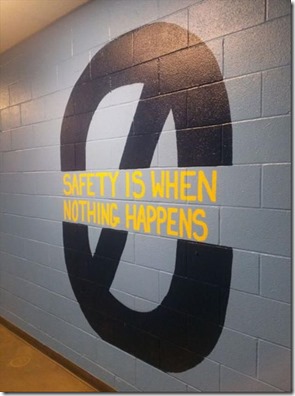 Safety is a balancing act (dialectic) between the Precautionary Principle and engaging in risk so far as is reasonably practicable (the ALARP Principle) (https://safetyrisk.net/when-safety-is-beyond-your-control/ ). Nowhere in the Legislation, Regulation or Standards is there any expectation of zero, this is because at its foundation, the ideology of zero is unethical. No lawyer worth their salt would ever try to defend zero in court (https://vimeo.com/163648220). Yet, zero is the global mantra for safety (http://visionzero.global/node/6) signed up to by the AIHS. No wonder the latest publication on Ethics by the AIHS (https://www.ohsbok.org.au/chapter-38-3-ethics-and-professional-practice/) doesn’t tackle this critical issue. When one’s Ethic is (undeclared) Utilitarian, Masculinst, Closed and Pragmatist then it’s best to remain avoidant of all debate and dialogue.
Safety is a balancing act (dialectic) between the Precautionary Principle and engaging in risk so far as is reasonably practicable (the ALARP Principle) (https://safetyrisk.net/when-safety-is-beyond-your-control/ ). Nowhere in the Legislation, Regulation or Standards is there any expectation of zero, this is because at its foundation, the ideology of zero is unethical. No lawyer worth their salt would ever try to defend zero in court (https://vimeo.com/163648220). Yet, zero is the global mantra for safety (http://visionzero.global/node/6) signed up to by the AIHS. No wonder the latest publication on Ethics by the AIHS (https://www.ohsbok.org.au/chapter-38-3-ethics-and-professional-practice/) doesn’t tackle this critical issue. When one’s Ethic is (undeclared) Utilitarian, Masculinst, Closed and Pragmatist then it’s best to remain avoidant of all debate and dialogue.
ALARP and the Precautionary Principle (PP) form the foundation of the safety dialectic. It is always a moving feast. Both principles are subjective and constrained by social context. Each assumes an Ethic of Risk.
If one becomes fixed on the PP one could not live, move or have being. If one keeps the bar low in ALARP then it can be open slather on risk. How these two principles are interpreted is constrained by one’s understanding of what is virtuous AND right. Similarly, Virtues Ethics AND Rights-based Ethics (evidence in Cardinal Rules) must be held in dialectic.
Our sense of virtue and vice stems from our definition of personhood and the values we associate with living ‘humanly’ in society. Our individual moral values and the way they are prioritized can easily put us in conflict with societal and organizational (systematized) ethics. Eg. the values of individualism and collectivism are a part of what separates conservative and socialist politics. These are also observable in the way organisations tackle risk. The idea that the choice should be binary is the projection of Zero. (In dialectic and can be both). When blame is projected onto workers often individualism is valued, when the organization bears blame for risk, collectivism is valued. No decision, ideology, value or policy in safety is ethically or morally neutral, including the hidden ethic in the WHS Act and Regulation. This is why Safety needs to articulate and Ethic of Risk.
The idea that an Ethic can be binary is the deception of Zero. The immoral binary question: ‘how many injuries do you want today?’ masks the assumption of numerics = safety. The binary logic of Zero is a method of entrapment which is a vice because it disrespects the integrity of the person receiving the question. The manipulation of another through entrapment is both immoral (individual) and unethical (systemic). If one has a methodology (Ethic) of respecting persons then entrapment cannot be the method. Similarly, the notion of Cardinal Rules emerges out of Zero ideology because it can only countenance absolutes. There can be no Ethic in absolutes over fallible persons.
Any Ethic of Risk must consider the reality of: fallibility, uncertainty, personhood, unpredictability, vulnerability, learning, fragility, faith-based decision making, subjective and wisdom. If any of these are recognized in any organizational policy then there can be no zero. If one is seeking the safety of self and others then one’s methodology (Ethic) needs to include all of these in consideration of a safety method. None of this is discussed in the AIHS BoK paper on Ethics.
9. BHP from Human Dymensions on Vimeo.



Do you have any thoughts? Please share them below